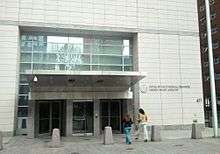Office of Chief Medical Examiner of the City of New York
| Chief Medical Examiner of the City of New York | |
|---|---|
|
Seal of the OCME | |
| Inaugural holder | Charles Norris |
| Formation | 1918 |
| Website | OCME |
The Office of Chief Medical Examiner of the City of New York (OCME) is a department within the city government that investigates cases of persons who die within New York City from criminal violence; by casualty or by suicide; suddenly, when in apparent good health; when unattended by a physician; in a correctional facility; or in any suspicious or unusual manner. The OCME also investigates when an application is made pursuant to law for a permit to cremate the body of a deceased person.
History

The office was established on January 1, 1918, pursuant to a 1915 act of the New York State Legislature that abolished the office of the Coroner of New York City. The Chief Medical Examiner is appointed by the mayor. Dr. Patrick D. Riordan was the last coroner and the first acting medical examiner from January 1, 1918 to February 1, 1918 when Dr. Charles Norris was appointed by the mayor as the first official Chief Medical Examiner of New York City.[1]
The OCME provides the citizens of New York City essential services directly by identifying the manner and cause of death in specified cases, as well as providing state-of-the-art forensic DNA analysis through the OCME Forensic Biology Laboratory.
These services include on-site investigation into manner and cause of death; identification of remains; performing autopsies; performing DNA testing related to identification of remains; examination of homicide, sexual assault, and other crime evidence collected by the Police Department for DNA extraction and typing; and responding to disasters that involve fatalities as part of a multidisciplinary team of city agencies.
List of Chief Medical Examiners
| no. | Name | Starting date of Office | Ending date of Office |
|---|---|---|---|
| Patrick D. Riordan (acting) as the last Coroner of New York City.[2] | January 1, 1918 | February 1918 | |
| 1 | Charles Norris[2] | February 1918 | 1935 |
| 2 | Thomas A. Gonzales[3] | 1935 | 1954 |
| 3 | Milton Helpern[4] | 1954 | 1974 |
| 4 | Dominick DiMaio | 1974 | 1978 |
| 5 | Michael Baden | 1978 | 1979 |
| 6 | Elliot M. Gross | 1979 | 1989 |
| 7 | Charles Sidney Hirsch[5] | 1989 | February 6, 2013 |
| Barbara Sampson (acting)[6] | February 6, 2013 | December 9, 2014 | |
| 8 | Barbara Sampson[6] | December 10, 2014 | Incumbent |
Unified Victim Identification System
In the aftermath of the numerous deaths resulting from the September 11 attacks on New York City and the crash of American Airlines Flight 587, the OCME developed the Unified Victim Identification System (UVIS). An Internet-enabled database system, it is intended to handle critical fatality management functions in the case of a major disaster with numerous deaths. It also has functionality to enable the OCME to respond to an influenza pandemic.[7]
Notes
- ↑ Evans, Colin. Blood on the Table; The Greatest Cases of New York City's Office of the Chief Medical Examiner, New York: The Berkley Publishing Group, 2008.
- 1 2 "Norris Succeeds Riordan". New York Times. February 1, 1918.
- ↑ "New Chief Medical Examiner Is Sworn In". New York Times. July 22, 1937.
- ↑ "Milton Helpern, Ex-Chief Medical Examiner, 75, Dies. With New York Office for 42 Years. Called a Sherlock Holmes". New York Times. April 23, 1977.
- ↑ "Charles S. Hirsch, New York's Chief Medical Examiner on 9/11, Dies at 79". New York Times. 10 April 2016. Retrieved 10 April 2016.
- 1 2 "Mayor de Blasio Appoints Dr. Barbara Sampson as Chief Medical Examiner | City of New York". Nyc.gov. 2014-12-10. Retrieved 2016-04-16.
- ↑ City of New York Office of Chief Medical Examiner Pandemic Influenza Surge Plan To Manage In-Hospital Deaths Planning Tool
External links
- NYC Office of Chief Medical Examiner
- U.S. Department of Health and Human Services Pandemic Influenza Plan
Coordinates: 40°44′29″N 73°58′30″W / 40.74139°N 73.97500°W
